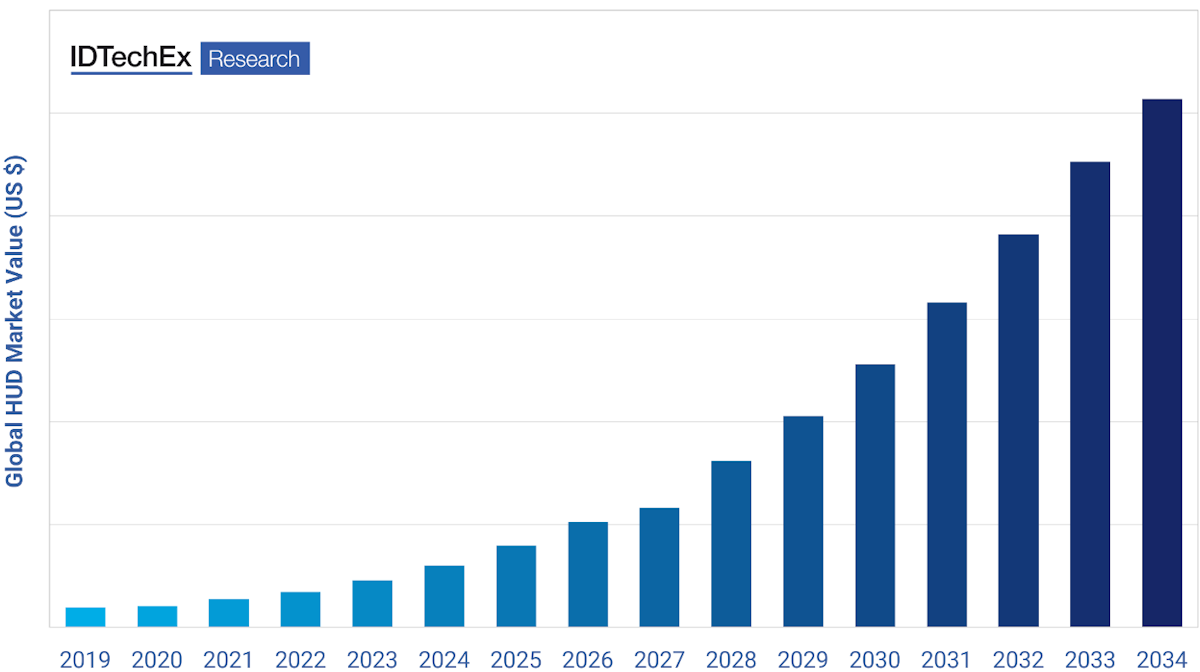Is a Focus on Road Safety Accelerating the Use of Heads-Up Displays?
Mar 15, 2024
Dr Xiaoxi He

With distracted driving accounting for 25% of all road accidents and young drivers accounting for the largest demographic using technology while driving, it is imperative to look for solutions to this problem.
It is believed that Heads-Up Displays (HUDs) could be a viable option to prevent driver distractions from other onboard technologies such as the dashboard and center information displays (CID). Drivers currently need to deviate their gaze from the road to look at the onboard diagnostics in the dashboard or the GPS, radio, and telephone in the CID. The use of HUDs means this information is now projected directly to the driver's line of sight.
The new IDTechEx report, "Automotive Heads-up Displays 2024-2034: Technologies, Players, Opportunities", provides comprehensive coverage into this space, from the most renowned 2-dimensional technologies to the more futuristic 3-dimensional imaging techniques that are set to revolutionize the automotive sector. This report also covers key trends, market analysis, opportunities, and granular 10-year forecasts for display volume (number of displays) and value (US$), segmenting the industry by display type and technology.
HUDs are met with a lot of enthusiasm. They are actively used in the aviation industry, and their potential to further assist the driver in the most adverse and complicated atmospheric conditions is a reason many stakeholders are advocating for its rapid adoption in the automotive space. There are three types of heads-up displays: dedicated combiner, windshield, and augmented reality (AR) HUDs. The combiner HUD involves projecting an image to a screen between the driver and the windshield. The virtual image is still directed at the driver's line of sight, but it is often retractable and does not interfere with the windshield's visibility. The windshield and AR-HUD both have virtual images projected at the windshield and require special coatings to prevent image doubling or ghosting effects. These two types of HUDs are expected to be more immersive, highlighting key obstacles on the road as well as on-board diagnostics (OBD).
This technology can, therefore, be useful in adverse weather conditions where the road's visibility is reduced. The HUD can be used to signal important obstacles and areas of concern.
However, there is a concern about moderation in the number of images and how immersive this technology must be. While it can be important to highlight road obstacles, too many annotations may be detrimental to a driver's focus on the road. Too many virtual images can significantly hinder the visibility of the road and can, in turn, impact safety. Finding the balance is important and appears to be the focus of companies in this sector.
HUDs are expected to grow over the coming decade, and technologies that are bright, highly responsive, resilient, durable, immersive, have a small form factor and are cost-effective are best positioned to succeed in this space. TFT-LCDs are the most popular option. However, the growth of computer-generated holography and microLEDs could challenge their dominance middle to long-term. With a CAGR of 24%, this market is expected to surpass US$10 billion by 2034.

IDTechEx forecast for HUDs market value in the next decade. Source: IDTechEx
IDTechEx's "Automotive Heads-up Displays 2024-2034: Technologies, Players, Opportunities" report analyses the main technologies and HUD types being developed and expected to grow over the next decade. The challenge in developing automotive HUDs is more than just ensuring the technology works accordingly; it must comply with the very stringent regulations the sector demands. Operating temperature requirements are wider than those in other sectors, for instance. Technologies in this space must endure harsher ambient conditions. This report covers key innovations in manufacturing as well as coating requirements to enhance the performance of HUDs.
For more details on the heads-up display market, please see the IDTechEx market report, "Automotive Heads-up Displays 2024-2034: Technologies, Players, Opportunities". Find out more, including downloadable sample pages, by visiting www.IDTechEx.com/AutoHUD.
For the full portfolio of market research available from IDTechEx, please visit www.IDTechEx.com.
IDTechEx provides trusted independent research on emerging technologies and their markets. Since 1999, we have been helping our clients to understand new technologies, their supply chains, market requirements, opportunities and forecasts. For more information, contact research@IDTechEx.com or visit www.IDTechEx.com.
Upcoming free-to-attend webinar
Navigating the Future: Evolution and Opportunities in Automotive Heads-Up Display (HUD) Technology
Dr Xiaoxi He, Research Director at IDTechEx and author of this article, will be presenting a free-to-attend webinar on the topic on Thursday 4 April 2024 - Navigating the Future: Evolution and Opportunities in Automotive Heads-Up Display (HUD) Technology.
The following points will be addressed:
- Classification of HUDs
- Requirements for HUDs
- Overview of PGU technology choices
- Future trend of AR HUDs and their value propositions
- Opportunities for suppliers in the HUD development value chain
Please click here to check timings and register for your specific time zone.
If you are unable to make the date, please register anyway to receive the links to the on-demand recording (available for a limited time) and webinar slides as soon as they are available.